Lower Suwannee NWR
~~~Aliens in splendid "new home water"
Aliens are in the Lower Suwannee National Wildlife Refuge. Before dawn September 4th, 2012, driving to the Refuge's Shell Mound, I stopped for several seconds to look at a 'cat' standing in the glare of my brights. It had a spectacularly long, striped tail---longer than itself. It was not a true cat, though. It was a "Ringtail," in the raccoon family, and should've been out West.
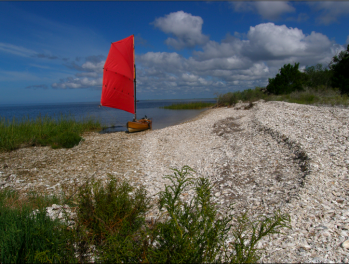 Last summer I talked with a fisherman on the Shell Mound pier. Several years earlier he'd been fishing from
a kayak, "...right over there," he said, pointing at the north end of Hog Island (Spanish Bayonet on some
charts). He'd seen a big snake swimming from the mainland. When the thick snake crawled aboard, he hacked
and flailed with his paddle, and, "...got it ten times really good, then another twenty just to be sure."
It was a seven foot Burmese python.
Last summer I talked with a fisherman on the Shell Mound pier. Several years earlier he'd been fishing from
a kayak, "...right over there," he said, pointing at the north end of Hog Island (Spanish Bayonet on some
charts). He'd seen a big snake swimming from the mainland. When the thick snake crawled aboard, he hacked
and flailed with his paddle, and, "...got it ten times really good, then another twenty just to be sure."
It was a seven foot Burmese python.
Since I saw the Ringtail, stories of aliens are more interesting. So, sailing canoe Bufflehead and I went looking for one.
When I drove with Bufflehead on a trailer to the Shell Mound mid morning in late September, it occurred to me I'd not sailed there since June 2010. My wife K and dad Hal were alive, and I'd been working on our Cedar Key house. My column then had been about "new home water." But changes came---brutal grief and sorrow, financial upheaval, pets in new homes, a romance and partner gone. So, a quest for an alien sounded good for Bufflehead and me.
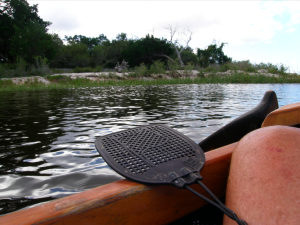 Where the python met the kayak fisherman at the north tip of Hog Island, I let the sheet hang
and looked warily with cartoon coyote eyes at the shore and water. Mullet soared and splashed back
in; egrets fished; no snakes. Biting stable flies were the only unwelcome boarders.
Where the python met the kayak fisherman at the north tip of Hog Island, I let the sheet hang
and looked warily with cartoon coyote eyes at the shore and water. Mullet soared and splashed back
in; egrets fished; no snakes. Biting stable flies were the only unwelcome boarders.
We fell off, starboard tack, at four knots on a conspicuously fine broad reach. With the tide nearing high, I beached her, scraping up onto a wave terraced, oyster shell spit. The geomorphologist in me compared those wave results to storm terraces of the Great Lakes. Nothing seemed alien.
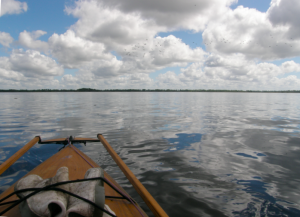 Our destination was Derrick Key, a port tack broad reach in the fading northeasterly off the land.
Ahead was a shifting mist of birds I knew was hundreds, maybe thousands, of Black skimmers.
Our destination was Derrick Key, a port tack broad reach in the fading northeasterly off the land.
Ahead was a shifting mist of birds I knew was hundreds, maybe thousands, of Black skimmers.
Sailing slowly under the high flying skimmers, one can't help but enjoy their flashing changes of direction. Spanish mackerel swirled and jumped at schools of leaping bait fish; Least terns and Brown pelicans dove on them. Through this splashy zone, chattering batches of skimmers flew just off the water---their heads level---skimming with their longer lower bills. A tern dove close off the bow, and popped up with a "glass minnow." The tern hovered in the sun at mast height, flipped the clear fish in the air, caught it facing down its gullet and zoomed away.
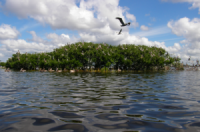 A sea breeze came from west southwest at four to six knots, so Bufflehead and I close reached
with a soft gurgle toward Derrick Key.
A sea breeze came from west southwest at four to six knots, so Bufflehead and I close reached
with a soft gurgle toward Derrick Key.
The Key's sand was nearly submerged by noon, an hour or so before high tide. Its mangroves were covered, but with Brown pelicans roosting and flapping, coming and going. Over a bar on the north side, some White pelicans floated with a hundred or so Browns. They all ignored us.
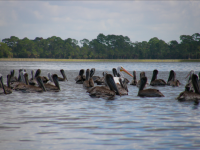 From Derrick we reached north northeast for red and green markers #2 and #3 of the Derrick Key Gap.
I'd wanted to find Dennis Creek from the Gulf, so, I broad reached northeast of the markers, poking up
winding leads ending in cord grass and black rush.
From Derrick we reached north northeast for red and green markers #2 and #3 of the Derrick Key Gap.
I'd wanted to find Dennis Creek from the Gulf, so, I broad reached northeast of the markers, poking up
winding leads ending in cord grass and black rush.
A fisherman was anchored in a canoe with an electric motor. I thought he'd caught something, but it was his anchor line. I bore away for another couple creeks, gybing in narrowing meanders, tacking back quickly. There were no wavelets, no splash, just tight pointing with the leeboard straight down, right up to the grassy edges of channels. Out by the anchored canoe, I asked if he'd caught anything?
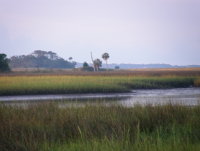 He answered with, I thought, a Scottish accent. I gestured 'thumbs up' and said hesitantly
but brightly, "For Scottish Nationalism."
He answered with, I thought, a Scottish accent. I gestured 'thumbs up' and said hesitantly
but brightly, "For Scottish Nationalism."
"Yes!" he thumbed up vigorously and shouted, "for Scottish Nationalism! 2014 will tell!"
Still chuckling, I close reached to the tiny island at the entrance to Dennis Creek. K would've enjoyed this day---I sprinkled a few of her ashes in the water lapping the beach.
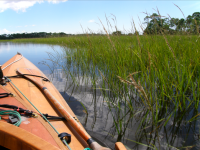 At two p.m. the sea breeze was six to seven. We reached back to the Shell Mound and were at the
house before three, to catch National Public Radio's "Science Friday," and Ira Flatow's talk of
familiar looking geomorphology on Mars.
At two p.m. the sea breeze was six to seven. We reached back to the Shell Mound and were at the
house before three, to catch National Public Radio's "Science Friday," and Ira Flatow's talk of
familiar looking geomorphology on Mars.
~ HH